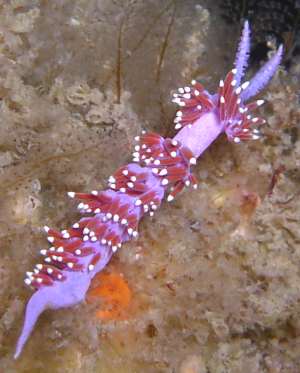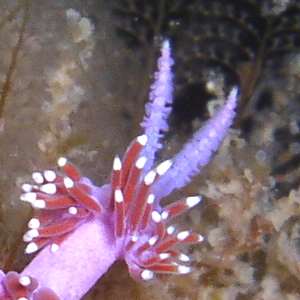

Flabellina funeka
Gosliner & Griffiths, 1981
Order: NUDIBRANCHIA
Suborder: AEOLIDINA
Family: Flabellinidae
DISTRIBUTION
Known only from the Indian Ocean side of Cape Province, South Africa. from Cape Point to Port Elizabeth (Gosliner, 1987).
PHOTO
Haerlam Wreck, Port Elizabeth, South Africa, 4 September 2004, 18 metres. Lower photo showing characteristic lamellae on rhinophores. Photos: Charles Rowe.
The body is a bright mauve or purple. The oral tentacles and rhinophores are also purple, but with white tips. The ceratal peduncles are also purple, while the skin of the cerata is tranlucent with the bright red digestive gland showing through. Each ceras has a subterminal band of opaque white.
The cerata are arranged in clusters, each cluster being supported by a common basal stalk or peduncle. The rhinophores are relatively thin and tapering but are characterised by 10 to 14 spaced lamellae which may be either entire, or broken. Animals grow to at least 40 mm in length. It is reported to feed exclusively on a gymnoblastic hydroid of the genus Eudendrium.
-
Gosliner, T.M. & Griffiths, R.J. (1981) Description and revision of some South African aeolidacean Nudibranchia (Mollusca, Gastropoda). Annals of the South African Museum, 84(2): 105-150.
-
Gosliner, T.M. (1987) Nudibranchs of Southern Africa, a guide to the Opisthobranchs of southern Africa. Sea Challengers, Monterey. 136 pages.
Rudman, W.B., 2005 (January 28) Flabellina funeka Gosliner & Griffiths, 1981. [In] Sea Slug Forum. Australian Museum, Sydney. Available from http://www.seaslugforum.net/find/flabfune
Related messages
Flabellina funeka from South Africa
January 29, 2005
From: Charles Rowe

Hi Bill,
Here is another nudi from Port Elizabeth I would like identified.
Haerlam Wreck, Port Elizabeth, South Africa, 4 September 2004. 18 metres
Thanks..
Charles
Charles.rowe@gmsa.com
Rowe, C., 2005 (Jan 29) Flabellina funeka from South Africa. [Message in] Sea Slug Forum. Australian Museum, Sydney. Available from http://www.seaslugforum.net/find/13045
Dear Charles,
This is another interesting addition to the Forum. It is Flabellina funeka, quite a spectacular flabellinid, apparently restricted to southern South Africa. In the close-up alongside you can see the characteristic platelike lamellae on the rhinophores.
Best wishes,
Bill Rudman
